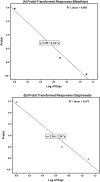Risk assessment of glyphosate and malathion pollution and their potential impact on Oreochromis niloticus: role of organic selenium supplementation
- PMID: 35705587
- PMCID: PMC9200714
- DOI: 10.1038/s41598-022-13216-y
Risk assessment of glyphosate and malathion pollution and their potential impact on Oreochromis niloticus: role of organic selenium supplementation
Abstract
A field survey was conducted on five fish farms to trace glyphosate and malathion pollution with some physicochemical parameters. A precise half-life time, LC50-96h, of these agrochemicals on Oreochromis niloticus, as well as chronic exposure with organic selenium (OS) supplementation, were experimentally investigated. Oreochromis niloticus was subjected to the following: (negative control); (2 mg L-1 glyphosate); (0.5 mg L-1 malathion); (glyphosate 1.6 mg L-1 and 0.3 mg L-1 malathion); (glyphosate 2 mg L-1 and OS 0.8 g kg-1 diet); (malathion 0.5 mg L-1 and OS 0.8 g kg-1 diet) and (glyphosate 1.6 mg L-1; malathion 0.3 mg L-1 and OS 0.8 g kg-1 diet). Furthermore, data from the analyzed pond revealed a medium risk quotient (RQ) for both agrochemicals. The detected agrochemicals were related to their application, and vegetation type surrounding the farms, also their biodegradation was correlated to water pH, temperature, and salinity. Glyphosate and malathion had half-lives of 2.8 and 2.3 days and LC50-96h of 2.331 and 0.738 mg L-1, respectively. The severest nervous symptoms; increased oxidative stress markers, as well as high bacterial count in the livers and kidneys of fish challenged with Aeromonas hydrophila, were observed in the combined exposure, followed by a single exposure to malathion and then glyphosate. Organic selenium mitigated these impacts.
© 2022. The Author(s).
Conflict of interest statement
The authors declare no competing interests.
Figures






Similar articles
-
Ameliorative effect of selenium yeast supplementation on the physio-pathological impacts of chronic exposure to glyphosate and or malathion in Oreochromis niloticus.BMC Vet Res. 2022 May 1;18(1):159. doi: 10.1186/s12917-022-03261-0. BMC Vet Res. 2022. PMID: 35501865 Free PMC article.
-
Dual effect of selenium loaded chitosan nanoparticles on growth, antioxidant, immune related genes expression, transcriptomics modulation of caspase 1, cytochrome P450 and heat shock protein and Aeromonas hydrophila resistance of Nile Tilapia (Oreochromis niloticus).Fish Shellfish Immunol. 2021 Mar;110:91-99. doi: 10.1016/j.fsi.2021.01.003. Epub 2021 Jan 14. Fish Shellfish Immunol. 2021. PMID: 33453383
-
Nano-selenium Supplementation to Ameliorate Nutrition Physiology, Immune Response, Antioxidant System and Disease Resistance Against Aeromonas hydrophila in Monosex Nile Tilapia (Oreochromis niloticus).Biol Trace Elem Res. 2021 Aug;199(8):3073-3088. doi: 10.1007/s12011-020-02416-0. Epub 2020 Oct 6. Biol Trace Elem Res. 2021. PMID: 33025518
-
Influences of Chlorella vulgaris dietary supplementation on growth performance, hematology, immune response and disease resistance in Oreochromis niloticus exposed to sub-lethal concentrations of penoxsulam herbicide.Fish Shellfish Immunol. 2018 Jun;77:445-456. doi: 10.1016/j.fsi.2018.04.011. Epub 2018 Apr 4. Fish Shellfish Immunol. 2018. PMID: 29626668
-
Glyphosate and aminomethylphosphonic acid impact on redox status and biotransformation in fish and the mitigating effects of diet supplementation.Vet Res Commun. 2024 Oct;48(5):2901-2914. doi: 10.1007/s11259-024-10481-2. Epub 2024 Jul 29. Vet Res Commun. 2024. PMID: 39073654 Review.
Cited by
-
Evaluation of phosphate insecticides and common herbicides: monitoring and risk assessment in water treatment plant, distribution networks, and underground water wells.J Water Health. 2024 Jun;22(6):1088-1101. doi: 10.2166/wh.2024.076. Epub 2024 May 16. J Water Health. 2024. PMID: 38935459
-
Selenium Nanoparticles Ameliorate Adverse Impacts of Aflatoxin in Nile Tilapia with Special Reference to Streptococcus agalactiae Infection.Biol Trace Elem Res. 2024 Oct;202(10):4767-4777. doi: 10.1007/s12011-023-04031-1. Epub 2023 Dec 26. Biol Trace Elem Res. 2024. PMID: 38147231 Free PMC article.
References
-
- FAO. Global aquaculture production 1950–2018. FishStatPlus-universal software online query panel for fishery statistical time series (2020).
-
- GAFRD. Fisheries Statistics Year Book for . General Authority for Fish Resources Development. Ministry of Agriculture and Land Reclamation; 2018. p. 2020.
-
- FAO. Fishery and aquaculture statistics. 110 Food and Agriculture Organization of the United Nations (FAO) Yearbook Rome, Italy (2021)
-
- Ghanem A, Haggag M. Assessment of the feasibility of using filter made of rice straw for treating aquaculture effluents in Egypt. Resour. Environ. Microbiol. 2015;5:135–145.
Publication types
MeSH terms
Substances
LinkOut - more resources
Full Text Sources

